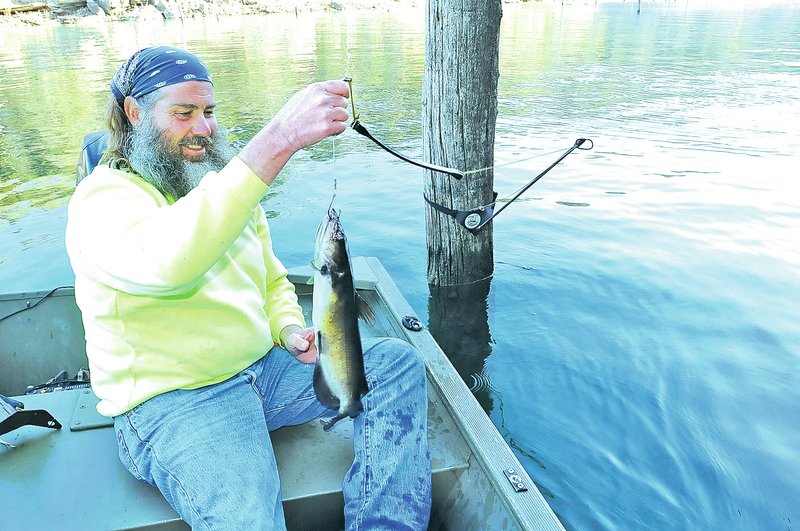lw
BEAVER LAKE
infotext
Out On A Limb
All limb lines and trotlines must be clearly labeled with the angler’s name and address, driver’s license number or vehicle license number, according to Arkansas Game & Fish Commission regulations.
The combined daily limit of channel, flathead or blue catfish is 10. There is no daily limit on bullhead catfish.
Information about Topcat fishing tackle is available at www.topcatfishingta…. Contact Steve Green at 913-449-9128 or [email protected]….
Source: Staff Report
Steve Green goes out on a limb for catfish, even when there's not a branch on the tree.
Tying fishing lines to tree limbs, or limb-lining, is a tactic of catfish chasers on lakes and rivers. Trouble is, not every fishy-looking tree in the water has limbs for attaching a hook and line. Green solves this problem with his Topcat fishing rods, a kind of artificial branch that Green makes in his garage.
Green's fishing innovations use a short, epoxy-composite fishing pole that is strapped around a tree trunk. Line goes through an eye at the end of the rod to a bungee cord. Another piece of line goes from the bottom of the bungee to a hook that dangles a few inches deep in the water.
The bungee cord takes some of the shock when one of the biggest fish in the lake, a flathead catfish, chomps down on the bait. Green always uses live bait such as sunfish. The key to catching catfish is hooking the bait so it splashes and thrashes on the surface. It's a siren song to a hungry catfish.
Green lives in Spring Hill, Kan., south of Kansas City, but he put his Topcat fishing rods to the test on April 25-26 during a visit to Beaver Lake.
Family Tradition
Catching big catfish got into Green's veins when he was a boy running trotlines with his grandpa. Later, Green started running trotlines and limb lines on his own from a canoe. Wrestling an angry, double-digit-sized catfish into a tippy boat proved a daredevil balancing act at times.
"A lot of the trees that I wanted to fish didn't have limbs, but they were in great spots. I had to fish trees that had branches," he said.
The angling entrepreneur started tinkering in his garage and came up with his strap-on rods. They're limbs for trees without limbs, Green said. A few improvements later, he started selling his Topcat fishing rods in 2010.
A water temperature of 60 to 80 degrees is prime for catching flathead, channel or blue catfish. Beaver Lake was close to 60 degrees when Green rolled into town last month, boat in tow, to visit friends and family. The Rambo arm of Beaver Lake in the Rocky Branch area is loaded with timber, the type of water Green looks for when he prowls for catfish.
He sets and baits lines in the evening, then runs them at dawn. Green set several Topcat lines in the back end of the Rambo arm on Thursday evening, April 24. It takes about a minute to attach and bait each line.
The fisherman was back before sunrise April 25 to collect the whiskered bounty. How many catfish will there be? What kind? That's the anticipation of limb lining.
Catch A 'Cat
Green's hopes were high for a 30-pound flathead, just like every bass fisherman hopes for an 8-pound largemouth each trip. The first few lines were limp, but the bait was gone. Clever thieves, these Beaver Lake catfish. Action picked up when Green idled into a timber-pocked cove. Here one of his Topcat rods danced with a splashing catfish on the line.
It wasn't the 30-pounder Green wanted. Instead, a fine-sized channel catfish sprayed water all over Green when he approached in the boat. The entrepreneur hoisted it aboard, then released the catfish.
As much as catfish are a species of catch and eat, Green releases most of his catch. When he does wrangle some big flatheads aboard, they fill up a freezer quick.
Green's nephew, Zach Smith, and Green's friend, Steven Castleman of Springdale, were along on this bright morning to run the lines. Castleman was in his own boat and plucked a couple more channel catfish from the hooks.
If the trio wanted fish to eat, they'd have a nice mess. Channel catfish would do, but Green was determined to catch a big flathead on his first trip to Beaver Lake. So determined that he stayed an extra day to give the fishing another go, this time in the War Eagle arm of Beaver.
The water is more stained on the south end of the lake than in the Rambo area. Green crossed fingers and toes for a flathead. Yet, when he and Castleman ran lines that Saturday morning, the take was one channel catfish.
Catfish Country
As in business, it's location times three when setting limb lines for catfish. Big slab rocks close to a tree are great targets for limb lines, Green said. He sets lines in water shallower than 10 feet.
"That's because those are going to hold bait fish. When the catfish come to feed, they'll hear your bait on the surface and think it's an easy meal. It's the splashing that really makes this work."
Green has caught some giant flathead 'cats. His largest is a 67-pounder caught at Hillsdale Lake near Kansas City. He's never had a whiskered foe pull one of his Topcat rods off a tree trunk. "But what's really cool is when you see the tip of that rod all the way down into the water."
That's when Green knows he's caught that big flathead he's always after.
Outdoors on 05/22/2014
